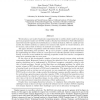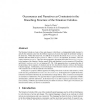14084 search results - page 2757 / 2817 » A Theory for Game Theories |
JMLR
2002
13 years 8 months ago
2002
We examine the learning-curve sampling method, an approach for applying machinelearning algorithms to large data sets. The approach is based on the observation that the computatio...
JCB
1998
13 years 8 months ago
1998
We introduce a new model of molecular computation that we call the sticker model. Like many previous proposals it makes use of DNA strands as the physical substrate in which infor...
DAM
1999
13 years 8 months ago
1999
The autocorrelation function of a sequence is a measure for how much the given sequence di ers from its translates. Periodic binary sequences with good correlation properties have...
MOC
2002
13 years 8 months ago
2002
Dimensionally unbounded problems are frequently encountered in practice, such as in simulations of stochastic processes, in particle and light transport problems and in the problem...
LOGCOM
1998
13 years 8 months ago
1998
The Situation Calculus is a logic of time and change in which there is a distinguished initial situation ¡£¢ and all other situations arise from the different sequences of acti...


